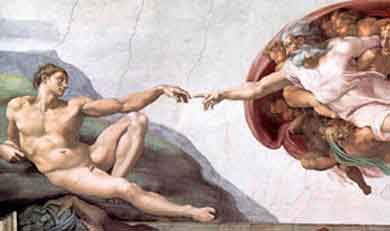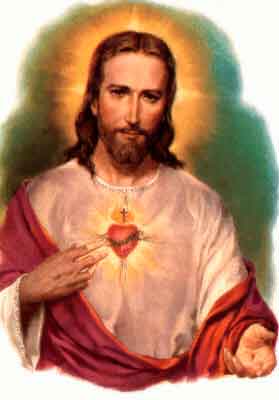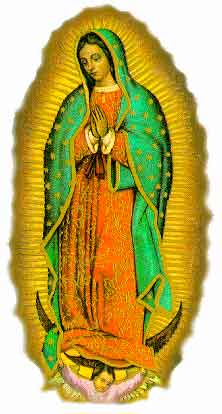CHRISTIAN IMAGES: SACRED HEART AND BEYOND
While Christians in the eastern Mediterranean venerated
standardized flat images of Christ and the saints, meant to evoke the mystery of
incarnation and God's connection to humanity, Christians in the western
Mediterranean (Catholics) developed a different vocabulary of holy imagery.
The walls of cathedrals were rich with imagery of Christ, biblical tales, and
saints, rendered in translucent glass that expanded the brilliance of earlier
mosaic art.
The line between images, fit for veneration, and art, fit
for aesthetic appreciation, became especially blurred in the period of the
Renaissance (sixteenth century CE). The art of church walls was no longer
a way of representing the divine-human connection, it was also the site at which
human "genius" expressed itself.
 This
famous image of God creating Adam comes from the Sistine Chapel--that is, a
chapel dedicated by the catholic Pope Sixtus in the Vatican. It was painted by the
renowned Italian artist Michelangelo, and it probably known better today as a
great "work of art" than as an example of devotional Christian art.
This
famous image of God creating Adam comes from the Sistine Chapel--that is, a
chapel dedicated by the catholic Pope Sixtus in the Vatican. It was painted by the
renowned Italian artist Michelangelo, and it probably known better today as a
great "work of art" than as an example of devotional Christian art.
Following the Reformation, Roman Catholics reinvigorated
their veneration of Jesus, Mary, and the saints by developing devotional images
of their own. These were similar to Eastern Orthodox icons, but more
artistically and devotionally flexible.
Two of the most common devotional images in the Roman
Catholic church are the "Sacred Heart" and the "Virgin of
Guadalupe."
The veneration of the Sacred Heart of Jesus (later
extended to the Immaculate Heart of the Virgin Mary) intertwines, and to some
extent simplifies, complex ideas about Jesus as God, as human, and as savior.
 The
standard image of the Sacred Heart of Jesus shows Jesus "in glory" (surrounding
by a halo of light, dressed in fine clothes), with a sort of "cut-away" image of
Jesus' heart. The heart (as pictured here) is surrounded by the crown of
thorns the Gospels claim Jesus wore during his crucifixion; the heart is also
crowned with light, and a cross. The face of Jesus (here, in a
particularly Anglo form) is usually serene. The image conveys at once the
suffering and sacrifice of Jesus, and the serenity and power of Jesus. The
veneration of Jesus' Sacred Heart, beginning towards the end of the eighteenth
century CE, transforms all of these complex images--suffering, power,
divinity, humanity--into a distinctly emotional register. The devotion to
the sacred heart is a devotion to a compassionate Jesus, and meant to invoke the
distinct emotional register of "love" in Christian worship.
The
standard image of the Sacred Heart of Jesus shows Jesus "in glory" (surrounding
by a halo of light, dressed in fine clothes), with a sort of "cut-away" image of
Jesus' heart. The heart (as pictured here) is surrounded by the crown of
thorns the Gospels claim Jesus wore during his crucifixion; the heart is also
crowned with light, and a cross. The face of Jesus (here, in a
particularly Anglo form) is usually serene. The image conveys at once the
suffering and sacrifice of Jesus, and the serenity and power of Jesus. The
veneration of Jesus' Sacred Heart, beginning towards the end of the eighteenth
century CE, transforms all of these complex images--suffering, power,
divinity, humanity--into a distinctly emotional register. The devotion to
the sacred heart is a devotion to a compassionate Jesus, and meant to invoke the
distinct emotional register of "love" in Christian worship.

While the Sacred Heart of Jesus responded to the
emotional, and devotional needs of modern Catholics, the image of the Virgin of
Guadalupe emerges out of a different set of devotional concerns: those of
colonialism and cultural preservation. The Virgin of Guadalupe (pictured
to the right in her typical form) was said to have appeared to a native Mexican
Indian (who had become Catholic and taken the European name "Juan Diego") and
performed miracles for him and the Catholics in Mexico only a few years after
the Spanish had conquered the Aztecs. Since then, the Virgin of Guadalupe
has been of particular significance to Latin American Catholics: a symbol
of colonial resistance and adaptation, and the favor of God's mother for the oppressed.
continue the slide show
 This
famous image of God creating Adam comes from the Sistine Chapel--that is, a
chapel dedicated by the catholic Pope Sixtus in the Vatican. It was painted by the
renowned Italian artist Michelangelo, and it probably known better today as a
great "work of art" than as an example of devotional Christian art.
This
famous image of God creating Adam comes from the Sistine Chapel--that is, a
chapel dedicated by the catholic Pope Sixtus in the Vatican. It was painted by the
renowned Italian artist Michelangelo, and it probably known better today as a
great "work of art" than as an example of devotional Christian art. The
standard image of the Sacred Heart of Jesus shows Jesus "in glory" (surrounding
by a halo of light, dressed in fine clothes), with a sort of "cut-away" image of
Jesus' heart. The heart (as pictured here) is surrounded by the crown of
thorns the Gospels claim Jesus wore during his crucifixion; the heart is also
crowned with light, and a cross. The face of Jesus (here, in a
particularly Anglo form) is usually serene. The image conveys at once the
suffering and sacrifice of Jesus, and the serenity and power of Jesus. The
veneration of Jesus' Sacred Heart, beginning towards the end of the eighteenth
century CE, transforms all of these complex images--suffering, power,
divinity, humanity--into a distinctly emotional register. The devotion to
the sacred heart is a devotion to a compassionate Jesus, and meant to invoke the
distinct emotional register of "love" in Christian worship.
The
standard image of the Sacred Heart of Jesus shows Jesus "in glory" (surrounding
by a halo of light, dressed in fine clothes), with a sort of "cut-away" image of
Jesus' heart. The heart (as pictured here) is surrounded by the crown of
thorns the Gospels claim Jesus wore during his crucifixion; the heart is also
crowned with light, and a cross. The face of Jesus (here, in a
particularly Anglo form) is usually serene. The image conveys at once the
suffering and sacrifice of Jesus, and the serenity and power of Jesus. The
veneration of Jesus' Sacred Heart, beginning towards the end of the eighteenth
century CE, transforms all of these complex images--suffering, power,
divinity, humanity--into a distinctly emotional register. The devotion to
the sacred heart is a devotion to a compassionate Jesus, and meant to invoke the
distinct emotional register of "love" in Christian worship.